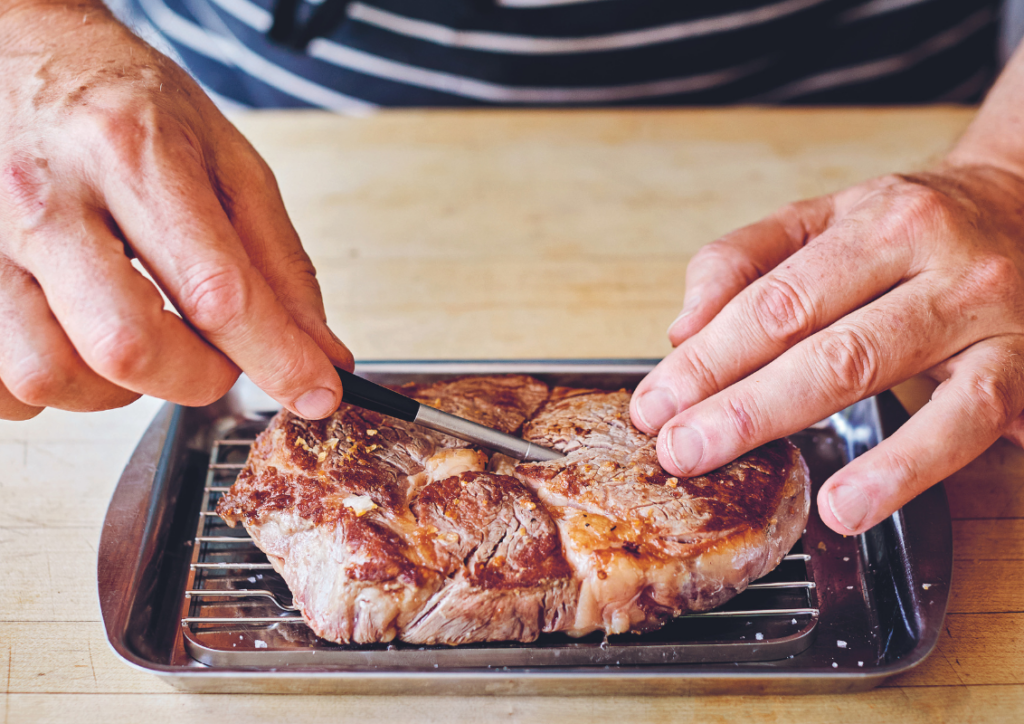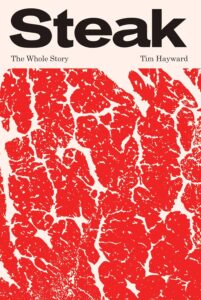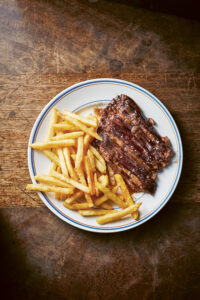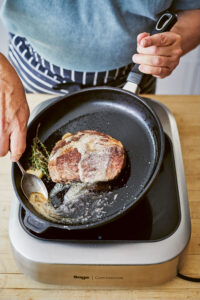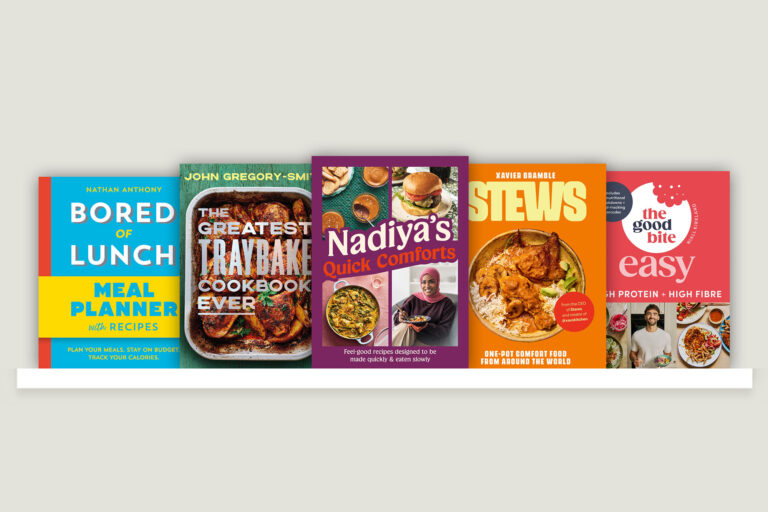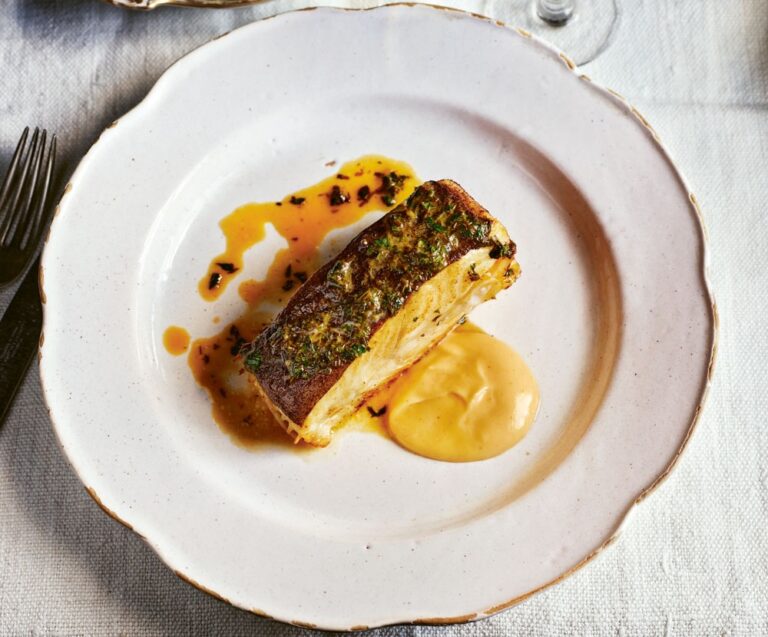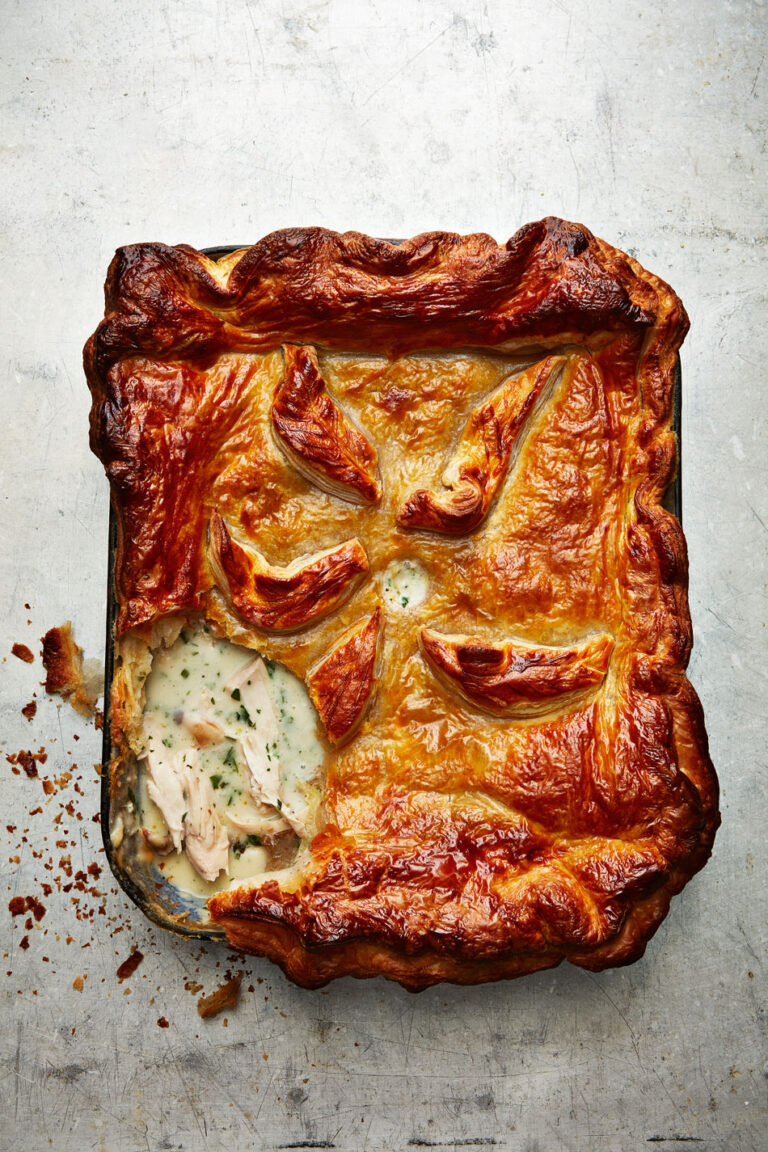Steak: The Whole Story is food writer Tim Hayward’s guide to the world of steak, exploring everything from the world’s best butchers, restaurants, and chefs, to the tips and recipes you need to make your favourite steaks and sauces at home. In this extract from the book, we learn about the key techniques for cooking the perfect steak including temperature curves, when to flip your steak, and how to pre-heat your pan.
Temperature Curves
Meat will always tend towards equilibrium of temperature, both within itself and with its environment. In a hot oven, the surface of a steak will rise quickly to equilibrium with the surrounding air temperature and the core will rise at a much slower rate towards the same temperature.
Once the steak is removed from the oven, the surface of the steak will move towards equilibrium with the room temperature (i.e. it will cool) and the core will move towards equilibrium with the surface (i.e. it will continue to get warmer).
Learn how to cook the perfect steak
Buy From
Cooking a thick piece of meat in a 200°C (400°F/ Gas 6) oven until its core reaches 50°C (122°F) will therefore result in a smooth gradient of temperature between the surface and the core.
This means that our aim when cooking a steak is to ensure:
1. Maximum heat on the surface.
2. Consistent internal temperature at the desired level.
Once we understand how the temperature gradient works within the meat, it becomes obvious that the shape of the cut is important. A thin cut will cook quickly, with the core rising easily to equilibrium with the surface and making it difficult to maintain a lower internal temperature. The higher ratio of surface to volume also means there will be more crust to meat. This is why quick-cook minute steaks can’t really be served rare and instead rely on good marinades and a deliciously complex flavour in the outer crust.
For a big, thick steak, cooking will be a longer and much more controllable procedure, meaning we can sear the outside and gently bring the core to the cuisson (that’s just French for ‘degree of doneness’) we want. The ideal shape for steak with a perfect medium-rare centre and a crisply crusted exterior might therefore be a squat cylinder, almost as tall as it was wide, with smooth sides that can be rolled around in the pan and a flat top and bottom. There’s a much higher ratio of meat to crust here, so the steak should be high quality, tender and juicy. In fact, what I’ve just described is pretty much the definition of a filet mignon or tournedos.
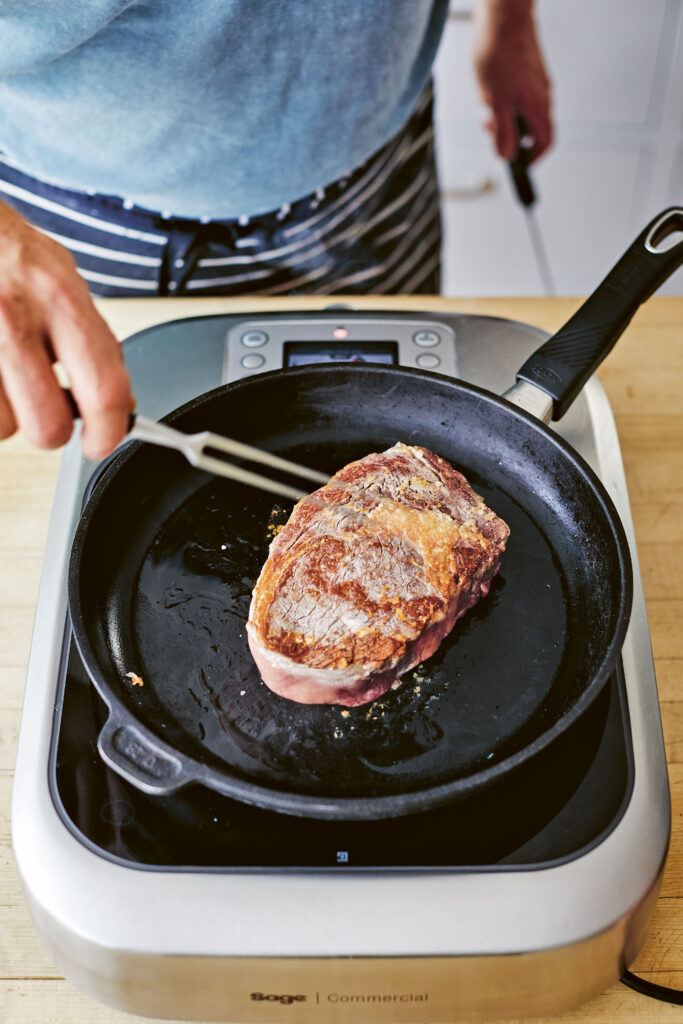
Flipping
The shape of the meat also points us towards the way we should handle it in the pan. A thin steak will sear quickly on one side and, once flipped, will sear just as quickly on the other. While the underside heats up, the top will lose temperature but, by the time the second side is browned, the core will be either cooked or very close.
With a thicker steak, this simple flip won’t work. If you sear a 3cm (1¼ in) steak one side and then flip it, the top will start to cool and the bottom will brown, but the middle will remain well short of cooked.
Regularly flipping the steak in the pan from the very beginning of cooking slows down the browning of the exterior and ensures it is even and controllable while also giving the core more time to come up to temperature. This frequent flipping works the same way as a rotisserie, by constantly changing the direction of movement of the juices within the meat, either by gravitational pull downwards or by the heat from below driving them upwards.
On anything thicker than a minute steak, I flip consistently at around 30-second intervals which, even if no more complicated technique is used, reliably cooks a steak of all but the most absurd thickness.
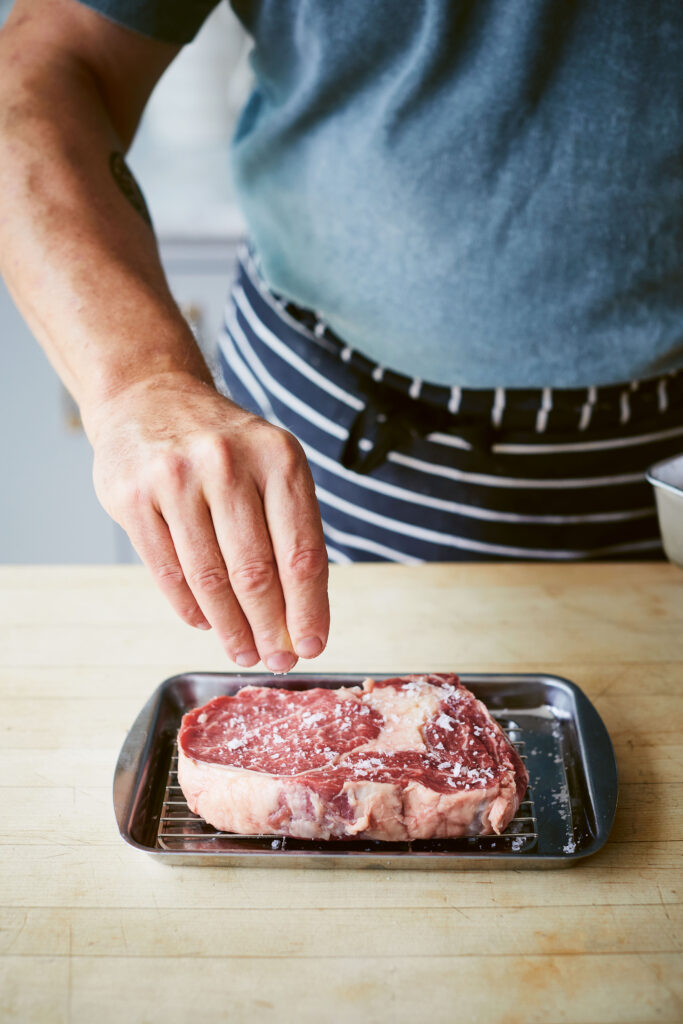
Leidenfrost and Non-stick Pans
You’ll have seen the Leidenfrost effect in action if you’ve ever put a drop of water into a hot pan or onto a hotplate and seen it skitter madly over the surface like an over-energetic hovercraft. And in fact, that’s exactly what it is. When a water droplet, held in shape by surface tension, hits a hot enough surface, it produces a vapour layer underneath itself which both supports and insulates it. It hovers there, on a cushion of steam, not evaporating.
It’s not a stable effect – sooner or later the little equilibrium breaks down and the droplet evaporates in an instant. There is a temperature below which the effect can’t take place and another above which it breaks down. The lower temperature is dependent on many factors, including the cooking surface material, the air temperature, pressure and humidity. Figures range from 193ºC (379ºF) to 250ºC (482ºF) depending on your source, but that range is useable for our purposes.
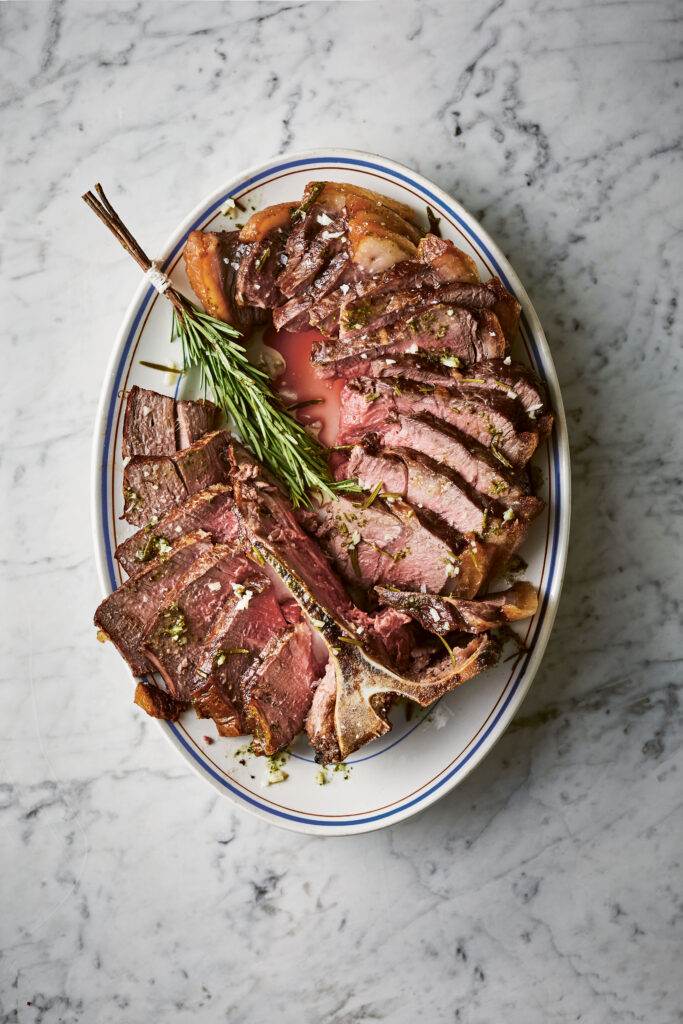
Now, if you look carefully at the label on a non-stick pan, you’ll see that it has an upper temperature limit. Usually, for Teflon (made from polytetrafluoroethylene, or PTFE), that’s around 260ºC (500ºF).56 Beyond that temperature, they say, your pan isn’t guaranteed. We obviously want our steak searing surface to go well above that.
In reality, a steak is far too big to ‘hover’, but the water-drop test is a good indicator that a pan is hot enough to create steam very quickly. If you can heat a pan to above the Leidenfrost point and keep it there when a big raw steak is dropped into it, then you can be sure that there’s going to be enough hot vapour under the steak that it won’t have a chance to stick at the beginning. And, once it’s been in the pan for a few seconds, the steak’s own fats will begin to lubricate the surface, effectively making your cast-iron or stainless-steel pan non-stick at proper searing temperatures.
This is why cooking a steak usually requires preheating a pan to as hot as you can. Bear in mind that the cold steak is going to drop the pan temperature quickly on contact, so there needs to be enough heat energy pumped in there to bring everything back up to temperature almost instantly.
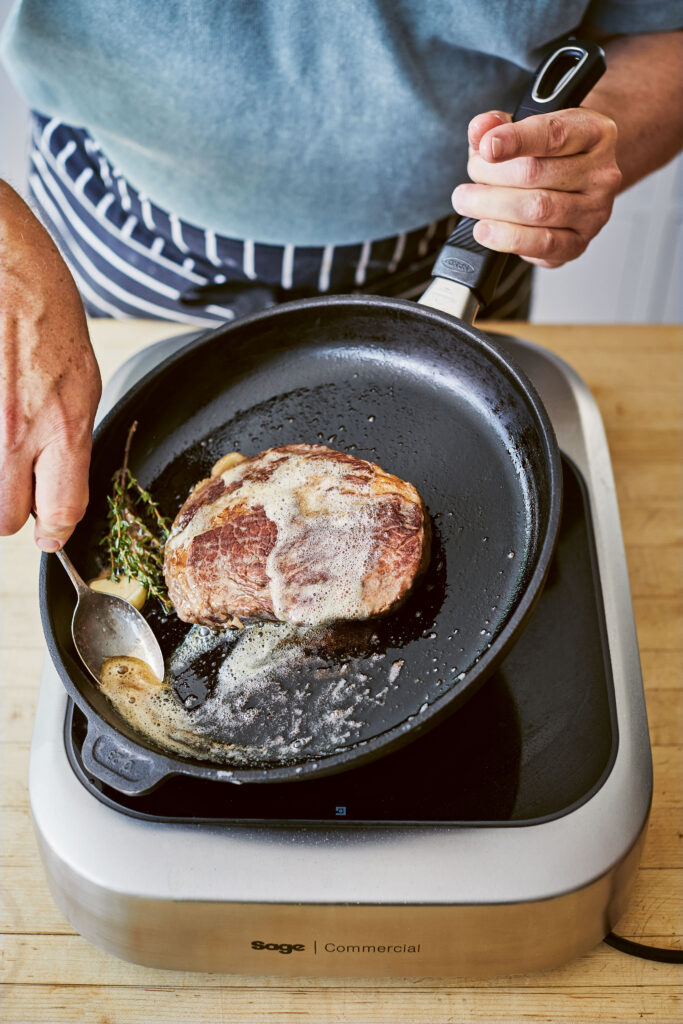
Back in the day, some diner cooks used the ‘spitball test’, in which they’d spit in the pan or onto the griddle and, when the ball danced, they knew it was time to drop in a steak. It’s a deeply unpleasant thought to our modern sensibilities, even though the heat of the grill would kill anything unhygienic the grill monkey might transmit.
Still…
I think I’ll stick to my laser thermometer.
All this means that for the purposes of the steak-cooking exercises and recipes that will follow, you should assume that, unless otherwise clearly specified, we’re always cooking in a cast-iron or stainless-steel frying pan, rendered non-stick by the brilliance of Dr Johann Gottlob Leidenfrost and A Tract About Some Qualities of Common Water.
To learn more steak cooking techniques, plus everything you need to know about the best steaks in the world, read Tim Hayward’s book Steak: The Whole Story.
